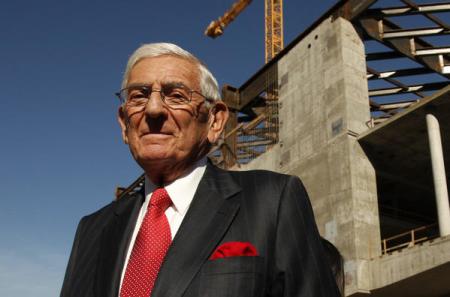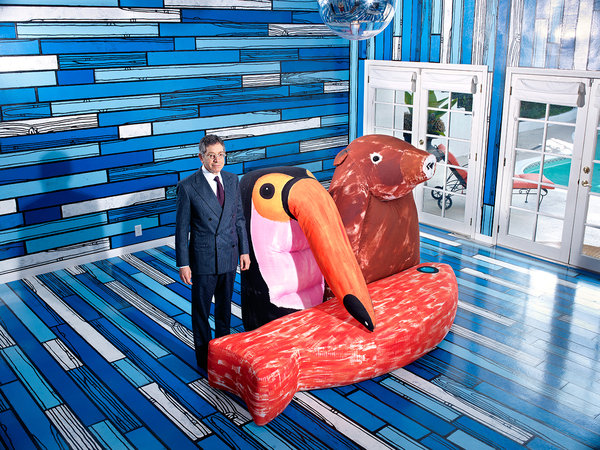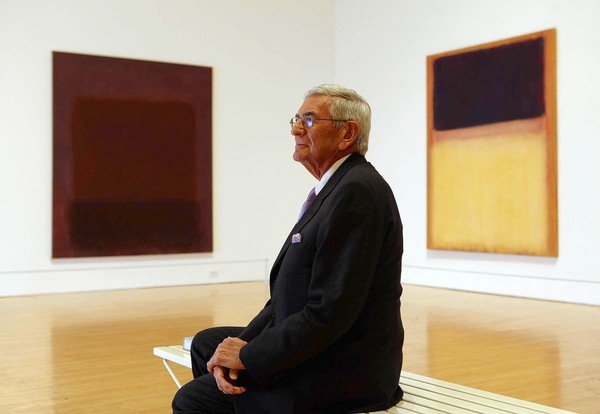Archive for the ‘MOCA’ Category
MOCA Leadership & Their Museums
Jeffrey Deitch will bid adieu to the Museum of Contemporary Art and the Best Coast and head back to New York, where his genius is appreciated and where he is already curating a show. Poor Deitch, un-hip, philistine LA just didn’t get him. The biggest Deitch defender in the press has been Art in the Streets associate curator (non-MOCA curator) Aaron Rose: “We had something going in L.A., and it’s over now. Jeffrey’s resigning is really a statement about what the city is. All people in L.A. want is interior design. They want paintings to put over the couch.” Let’s leave generalizations about “people in L.A.” out of this Aaron Rose, and take a moment to remember that time New York Times Magazine did a spread on “Jeffrey’s Deitch’s Party House.” Let’s talk about that interior design Aaron Rose: Deitch may not have paintings over his couch, but he does have painted couches.
Chapter 2 (Part 3): Venture Philanthropy & Other Styles of Giving
“Andrew Carnegie said, ‘He who dies with wealth dies in shame.’ And someone once said, ‘He who gives while he lives also knows where it goes.’”[i] – Eli Broad
Eli Broad’s power is tolerated because it remains remarkably unchallenged. This seemingly monopoly of philanthropic power led Christopher Knight to compare Broad to another infamous, Los Angeles art patron:
[Norton] Simon’s flirtations with giving [his] collection away (to at least seven institutions); distrust of traditional museum management; engineering of a bailout of an artistically adventuresome but financially faltering institution (the old Pasadena Museum for Simon, MOCA for Broad); later deciding to open his own museum, and more…[ii]
Another similarity to Broad: Before Norton Simon’s takeover of the Pasadena Art Museum, Simon had intended to establish his collection as a lending organization. Taking control of the Pasadena Art Museum proved irresistible to Simon, and today the Norton Simon Museum rarely loans works. I seriously doubt unfounded rumors that Broad has some kind of evil master plan to takeover or somehow combine his collections with MOCA.
Broad can also be measured to his contemporaries. Los Angeles is not actually a one-philanthropist town. “Pomegranate Queen” Lynda Resnick is an easy comparison. Like Broad, Resnick is a long-time donor and trustee of LACMA. Like Broad, she and her husband provided funds ($54 million) for a Renzo-Piano-designed building at LACMA. The Lynda and Stuart Resnick Pavilion was part of Phase 2 of LACMA’s Transformation and sits directly north of BCAM. When the pavilion opened in October of 2010, one of three inaugural shows was gleaned from the Resnick’s private collection.
Chapter 1 (Part 3): MOCA’s White Knight
“I had no intention of getting involved in MOCA, until it got into trouble”[i]
– Eli Broad
In fall 2008, a long-term beneficiary of Eli Broad’s largesse was in alarming financial trouble; the Museum of Contemporary Art (MOCA) could no longer hide its vertiginous financial mess. In an article titled “L.a.’s Moca In Deep Financial Trouble,” the Los Angeles Times reported MOCA had mismanaged its finances for more than a decade.[ii] The board of trustees had almost completely drained the $200 million endowment by regularly dipping into it to cover costs of expensive exhibitions and operating overhead; overspending an average $1 million a year since 2000.[iii] The public was shocked and enraged; consequently, there was a rapid exodus of board members.[iv] MOCA needed a hero with a rescue plan.
LACMA’s Michael Govan proposed one rescue plan: a partnership in which MOCA would maintain its independence and retain at least one of its venues (the Geffen Contemporary in Little Tokyo) and in exchange MOCA would share its collection with LACMA.[v] Details of the offer were never fully disclosed, but it seemed to be Govan’s attempt to secure a large and well-regarded contemporary art collection for LACMA, and a way to reduce (if not eliminate) LACMA’s need of the Broad collections.
Govan’s offer seemed to be the final straw in the already strained relationship between him and Broad. Broad openly chastised Govan in the Los Angeles Times for his proposed merger plan, and curiously quoted the film Jerry McGuire to demand, “Show me the money.”[vi] Broad had proposed his own rescue plan and was offering a $30 million lifeline to MOCA. Govan was meddling in his plans.





